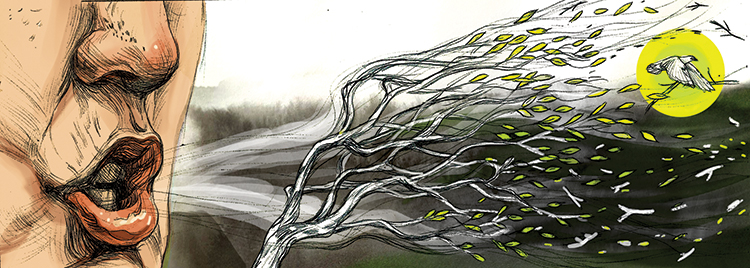Illustration by Nicholas Massarrelli
Eliminating Blight
by Eastwick Friends & Neighbors Coalition
A blighted neighborhood… what does that mean? For many, the word conjures images of cracked sidewalks, strewn trash, rusty cars and homes in need of a paint job. But are any Philadelphia neighborhoods free of such features?
According to Pennsylvania Urban Redevelopment Law, seven criteria are used to determine whether blight exists in an area, and the above description would meet many of them. But only one of those criteria needs to be met to establish a property or an area as blighted—a first step in the process by which city officials may use eminent domain to seize land from homeowners.
Although the term seems neutral, the history of blight is also deeply rooted in racism. For decades, local governments have used the term to condemn areas predominated by racial and ethnic minorities and immigrants.
For Eastwick, a primarily African-American and immigrant neighborhood in Southwest Philadelphia, this has meant trouble. The term was originally applied to Eastwick in the 1950s by people who didn’t live here, by officials who set out to create a new “city within a city,” without respect for existing community cohesion. In 2006, Eastwick was recertified as “blighted,” a designation that residents feel strongly continues to hold the Eastwick community back. Now, in 2016, it’s time to eliminate “blight”—a word that has become synonymous with racism and injustice—from the vocabulary of city planning officials.
To understand Eastwick’s future, we must acknowledge its past. Eastwick was officially designated as blighted in December 1950 by the city of Philadelphia planning and redevelopment agencies. This action facilitated the largest urban redevelopment project in history, in which more than 2,100 acres of land were condemned and seized. Over the next half-century, the Korman Corp. held the rights to redevelop and renew Eastwick. Old brick homes were razed and replaced by modern buildings, streets were planned and paved for new cul-de-sacs, and the Penrose Plaza was conceived and constructed.
In the name of urban renewal, more than 8,600 people—bewildered, frustrated and angry—were displaced. Many of them protested, unsuccessfully, the forced sale of their homes. Families, churches and local businesses were forced to leave; most never returned. A peaceful, racially integrated community known as the Meadows was effectively destroyed.
Despite the city-led redevelopment, Eastwick’s blight certification was renewed in March 2006 under the Street administration. The recertification cites evidence of three of the seven criteria used to define blight: 1) unsafe, unsanitary, inadequate, or overcrowded conditions; 2) faulty street and lot layout; and 3) “economically or socially undesirable” land use.
However, the report fails to mention that the Philadelphia Redevelopment Authority, not individual Eastwick residents, held title to the 162 acres of “vacant land” relied upon to recertify Eastwick as blighted; that the illegal dumping was occurring on that same publicly owned land; or that there was no intent to relocate the industrial activity that aggravated blight conditions in this environmentally vulnerable area.
In short, Eastwick residents—the individuals most impacted by the blight designation—played no role in creating so-called blighted conditions.
Today, this blight status—and the police power it represents—remains. It’s a significant concern for Eastwick residents, many of whom have lived here for decades. Attracted to this peaceful corner of Philadelphia, cradled by the trails along Cobbs Creek and the trees of John Heinz National Wildlife Refuge, Eastwick’s residents—before and since the ill-fated urban redevelopment project—do not see their community as blighted. But they have no power to change these conditions going forward, even though they have committed to staying in the neighborhood and organizing to protect their community.
Community activists—dedicated residents such as Earl Wilson, Leonard Stewart, Ramona Rousseau-Reid, Joanne Graham and Eastwick Friends & Neighbors Coalition (EFNC) President Terry Williams—have come together with renewed energy, working hard to make Eastwick whole, despite deep-seated distrust of a city that disenfranchised and disrespected their elders years ago.
They are proud of the storied history of Eastwick, and they are looking forward to the next chapters of change.
The EFNC is dedicated to engaging and empowering those residents, advocating for an environmentally, economically and socially sustainable future for the community. EFNC is working with elected officials and city agencies to ensure that future planning in Eastwick is conducted with residents, not for them. The recently approved Lower Southwest District Plan incorporated significant community input and is, thus, a step in the right direction.
The blight designation, however, remains in force in Eastwick.
EFNC believes that the term “blight” is an archaic tool that has no place in modern urban planning. We call for a public discussion in order for city officials to understand the long-term social and developmental impacts of the blight designation, and for a clear and transparent pathway for removing a designation that is impeding the forward progress of Eastwick.
The negative social and psychological impacts of the label are real. As a blight designation initiated a painful chapter of Eastwick’s history, removing the designation would be an auspicious start for the next one.
Eastwick Friends & Neighbors Coalition in Southwest Philadelphia brings together community stakeholders in planning and advocating for an environmentally, economically and socially sustainable future for Eastwick. For information or to get involved, email eastwickfnc@gmail.com or visit eastwickfriends.wordpress.com.








City Council itself has become a blight upon the progress of our place. "Philadelphia’s Poverty Industry" explains that the profitable exploitation of the poor makes it essentially illegal to end poverty here. Solutions are introduced. http://www.huffingtonpost.com/entry/philadelphias-poverty-industry_us_5762bf8ae4b07d4d0a41c855?avkwfa4plb3i35wmi